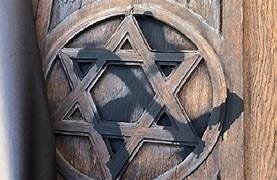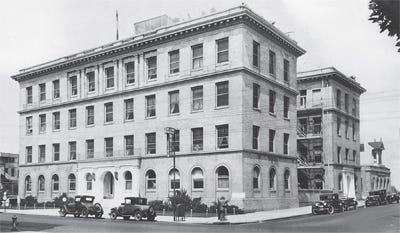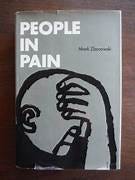In the last few weeks antisemitism has surged in the United States and around the world. I hope that this memoir will help people remember that Jews are a people to be treasured and valued like all people everywhere.
Many years ago, in the mid-70s when I was a graduate student in both public health and anthropology at UC Berkeley, I did an internship at Mt. Zion Hospital in San Francisco, which is now part of the University of California’s health sciences campus, UC San Francisco.
The hospital was founded in 1887 to serve the poor and needy without regard to race or creed. It was also a place where Jewish doctors could practice since they were not welcome at other hospitals. Additionally, it was a place of good care for Jews who were not welcome in most places. Mt. Zion was the only hospital that would admit African American doctors and their patients when it was founded. It served victims of the 1906 earthquake, flue epidemic patients in 1918, and it opened its doors to thousands of Jewish refugees in the 1940s.
When I was there in 1975, it was still serving the low-income disadvantaged residents of the Western Addition district of “The City.” Like the rest of San Francisco, it was compact and high rise. The Hospital operated at a steep loss of millions of dollars per year that was always covered by contributions from the San Francisco Jewish community. Wealthy Jewish women, some of whom were Holocaust survivors, put on their modest volunteer vests and did their best for patients and those who wandered in.
The outpatient department where I worked was a newer post-war facility at the intersection of Sutter and Divisadero. Its walls were painted in various shades of off-white. It was meticulously clean. Groups of older Jewish men who had left Russia and its gulags during those years of the Cold War, clustered in small groups talking and visiting in Russian with a certain well-deserved guardedness. Solzhenitsyn’s Gulag Archipelago, which was written from 1958 to 1968, had been published underground. The work had just been published in Paris in three volumes in 1973. These men had literally stepped out of Solzhenitsyn’s pages.
Mt. Zion was a medical home for African Americans, Asians, Pacific Islanders, Jewish emigrees and refugees, from the Soviet Union and around the world. The hospital had a contract with the State Department of Israel to treat Israeli students, a group that included both Jews and Palestinians.
The medical staff and the administration were still heavily Jewish. It still had a culture that felt very Jewish to me as a Mexican American goy (non-Jew). My own Catholic culture at the time was also starting to open up to outsiders. Catholic hospitals and other institutions were starting to be more diverse and less culturally Catholic. The ethnic and religious enclaves of San Francisco were starting to break up. The Chinese had long since left Chinatown. The Italians and the Irish had left for the suburbs, but they still dominated the police and fire departments, as well as City Hall. Jewish doctors and health care professionals were now part of the mainstream. There was still prejudice and pejorative or outright racist epithets. The Civil Rights Act was not even 10 years old and there were overt tensions. Discrimination in housing and employment were rampant. Cesar Chavez had his first successes with the farmworkers. There was talk of something called Chicano Studies.
My Latin features and olive skin made them take me for a Sephardic (Spanish) Jew. I told people the truth that I was a Catholic goy studying at Berkeley. They made me feel very welcome. My bilingual and bi-cultural code switching – my cultural chameleon skills – were helpful. However, there was some measure of disappointment among the older women volunteers. One lady wanted me to meet her granddaughter. Then she noticed my wedding band. A not so discrete two-word whisper from one of her companions with the words goy and Catholic produced a look of kindly consternation and grace. “Oh, such a nice young man.” I was far from offended as she took her hand in mind and patted my wedding band.
I was something of a dark universal everyman. Iranian students on campus greeted me in Farsi. I received shouts of salaam from Middle Eastern students. People thought that the Chicano kid from Ventura Avenue was Greek, Romanian, Italian. Even my wife said that I looked Portuguese.
The outpatient clinics were managed by African American nurses who were strong, confident, and compassionate but who brooked no nonsense. African American young men called them “the Mamas” with a sense of both respect and dread. They were equal opportunity enforcers. They also had the unenviable task of trying to keep medical student interns who were seeing their first patients moving fast enough to treat the long lines of patients queued at their treatment room doors.
The Mamas had their work cut out for them when Jewish and Palestinian Israelis lined up for care. As the line started to form, the Palestinians would attempt to push in front of the Jews. I was struck by this rudeness until one of the Jewish doctors came up to me with a certain weariness and let me in on the reason for the behavior. He said, “The Palestinians, based on their experience, think that if they are at the end of the line there will be nothing when their turn comes.” The lines were straightened out with assurances that everyone would see the doctor. As things settled down a couple of the Russian gulag survivors looked over and one commented grumpily, “In Russia they would just shoot them.”
I was also pursuing a doctorate in social cultural anthropology and applied for the internship because the hospital had its own medical anthropologist, Dr. Mark Zborowski. His ethnography, Life is with People, documented life in the Jewish shtetls (communities) in Eastern Europe between the wars. It also became the inspiration for the musical, “Fiddler on the Roof.” Dr. Z, as he was called, would spell his name for people saying, “Z like Zbigniew and B like Brzezinski.” (Mr. Brzezinski, a Polish American, had been President Johnson’s National Security Advisor.)
Mark Zborowski had set up a special program for managing chronic pain along with Dr. Bertram Feinstein. Dr. Feinstein was married to a prominent local politician, Diane Feinstein, who would blaze the way for women in politics and become one of the longest serving United States Senators. Senator Feinstein had gone to high school at one of the City’s most prestigious schools for girls, The Convent of the Sacred Heart. She graduated in 1951, went on to Stanford, and graduated with a degree in history in 1955.
The pain center had a whole complement of specialists including Dr. Z, who looked at the social and cultural context of a person’s chronic pain. By the time patients got referred to the pain center, many of them had multiple surgeries which had not helped their suffering and in some cases made it worse. Zborowski’s was an early and pioneering example of the contribution anthropology could make in the clinical setting.
In pleasant side conversations, I learned from Zborowski that there was a difference between pain and our response to it - suffering. In his pioneering book, People in Pain, he spoke about the way people from different cultures respond to pain within their patterns of culture. The book was very popular and influential. It came under criticism years later when viewed from a more advanced standpoint.
Nevertheless, later studies using galvanic skin potential readings to measure pain reactions tended to support his notion of culturally patterned responses to pain. Zborowski set the direction of pain studies for 20 years. J. A. Incandela’s March 1993 article in the Journal of Social Science and Medicine, “Social science and the study of pain since Zborowski: a need for a new agenda” describes Zborowski’s achievement.
For its time, the pain center, with its interdisciplinary approach and its integration of non-medical specialists including anthropology, psychology, and social work, laid the foundations of what would lead to a broader understanding of the whole person in chronic pain and ways in which people might be helped. In private consultations, he would ask, “What is good about your pain.” The question was meant to elicit how this very real pain had affected their lives. In some cases, it removed them from situations or obligations which were even more painful. Often it was a sign of a deeper alienation. Of course, in the 1970s, there was no such thing as an MRI or even a CAT scan. There were x-rays and that was about it. Neurology and neuroscience were still in their infancy.
Zborowski was not only an anthropologist who studied at the Sorbonne in Paris, he had also been a Soviet spy who successfully infiltrated the anti-Stalinist Trotsky movement and was complicit in the death of key members of the network including Trotsky’s son Lev Sedov. Lev Davidovich Bronshtein known as Leon Trotsky was the leader of Bolshevik forces during the Revolution of 1917. After the death of Lenin he lost out to Joseph Stalin.
Zborowski’s whole story requires its own separate post. The famous anthropologist, Margaret Mead was one of his supporters. Zborowski had told her that the reason he became a spy was that Stalin had threatened his family. Margaret Mead used her prestige and influence to get him his position at Mt. Zion which enveloped him in a cloak of respectability.
No one mentioned his conviction for lying under oath to a Congressional sub-committee about the length of his service to Joseph Stalin. Zborowski had been released from Danbury Federal Prison in 1965 after serving about two years of a seven year sentence, ostensibly for good behavior but I suspect that there may have been some “exchange of information” with the United States Government. I met him 10 years later.
No one spoke of these things and many graduate students who worked with him, myself included, were not aware of his past. He was an anthropologist of renown for his book on Jewish life in Eastern Europe before World War II, Life is with People. Interestingly, my academic supervisors and mentors never objected. I only came to know the complete story with the advent of the internet and publicity about Russian agents after the fall of the Soviet Union.
Privacy, anonymity, and codes of silence in the decades before the internet allowed people to reinvent themselves in ways which are now inconceivable to us.
For a concise history of Mark Zborowski, I recommend Steven J. Zipperstein’s Article in the summer 2010 issue of the Jewish Review of Books, “Underground Man: The Curious Case of Mark Zborowski and the Writing of a Modern Jewish Classic”
The title refers to Zborowski’s Life is With People which was a popular classic and stayed in print for 60 years. Zborowski’s research for the book had been done in conjunction with two of the biggest names in American anthropology, Margaret Mead and Ruth Benedict. The book was written in the 1940’s at Columbia University with funding from the Office of Naval Intelligence. It was published in 1952 with an introduction by Margaret Mead and Elizabeth Herzog.
Zipperstein describes Zborowski’s severe physical and psychological abuse by his parents as a child and adolescent. Based in part on what I learned from Zborowski’s ideas on pain and trauma, I would say that Zborowski’s adoption of an alternate persona and living a double life are all part and parcel of his incredible pain and trauma and was also a response to the validation he received from the man who recruited him to spy on the Trotskyites. There’s much more to it but while his traumatic abuse provides a lot of context, it does not excuse his action. To me he was professorial without being condescending. He was insightful without being aloof. He did not have a doctorate. He had studied at the Sorbonne but he never received a doctorate. He just let people call him “Dr. Z.”
My assignment working for Dr. Z was to supervise the coding and processing of survey data from pain center patients. I had just finished working on a large survey on the relationship between lifestyle and health status for the California State Department of Health. Everything was encoded on punch cards. Most of the time, our trays of machine and hand sorted punch cards made it from the State Health Department in Berkeley to the state’s mainframe computer for Medi-Cal (Medicaid) in Sacramento on the evening bus without mishap. However, there were a couple of times when they ended up on the floor of the mail room in Sacramento.
My project at Mount Zion required several trips to the hospital’s data processing department. For some reason, my job could never get priority. I offered to take it to an outside vendor but was rebuffed. There was some sort of internal struggle going on which I steered clear of. I had a nice research stipend and it allowed me not only to observe the administration of the hospital but to take in its Jewish culture of service and philanthropy for refugees and the disadvantaged. The history of Jews in San Francisco is rich and varied. However, the community was reeling from the destruction of European Jews and Jewish culture. Israel was still a fragile experiment but a source of hope and possibility.
It was a good place for an anthropologist in training. My most important experience at Mt. Zion was brief, but it was startling and searing. One day as I made one of my futile trips to data processing, I was walking with one of the programmers. He was a refugee who had lost his family in the Holocaust. It was a beautiful day, filled with sunshine under a blue sky. He turned to me and asked “Randy, where will we go next?” I looked up and was pleased that he thought I was a Jew, but I felt the need not to mislead him. Yet, something held me back. Saying I was not a Jew seemed like it would somehow distance me from his story and his pain. I didn’t want to somehow say or imply that it wasn’t my worry. As a Mexican American, I had a small glimpse of what Jews experience every day. It became my worry. He looked at me with a definite sadness in the beautiful sunlight and said “Randy, where will we go when we can stay here no longer?” All I could do was to shake my head and look down, away from the beautiful sky into our shadows as we walked.
Where? Indeed.










It’s very interesting article for me. Thank you.